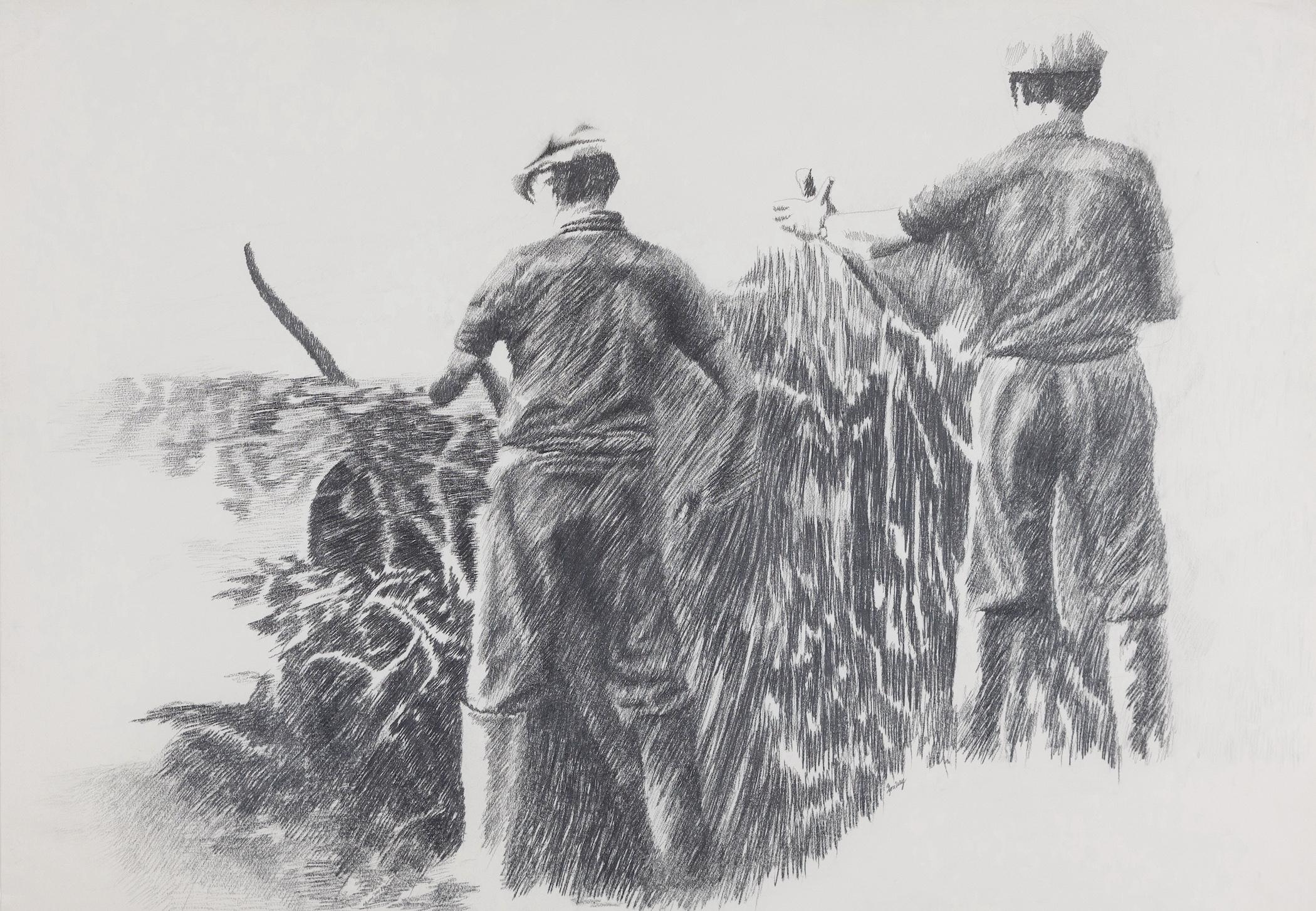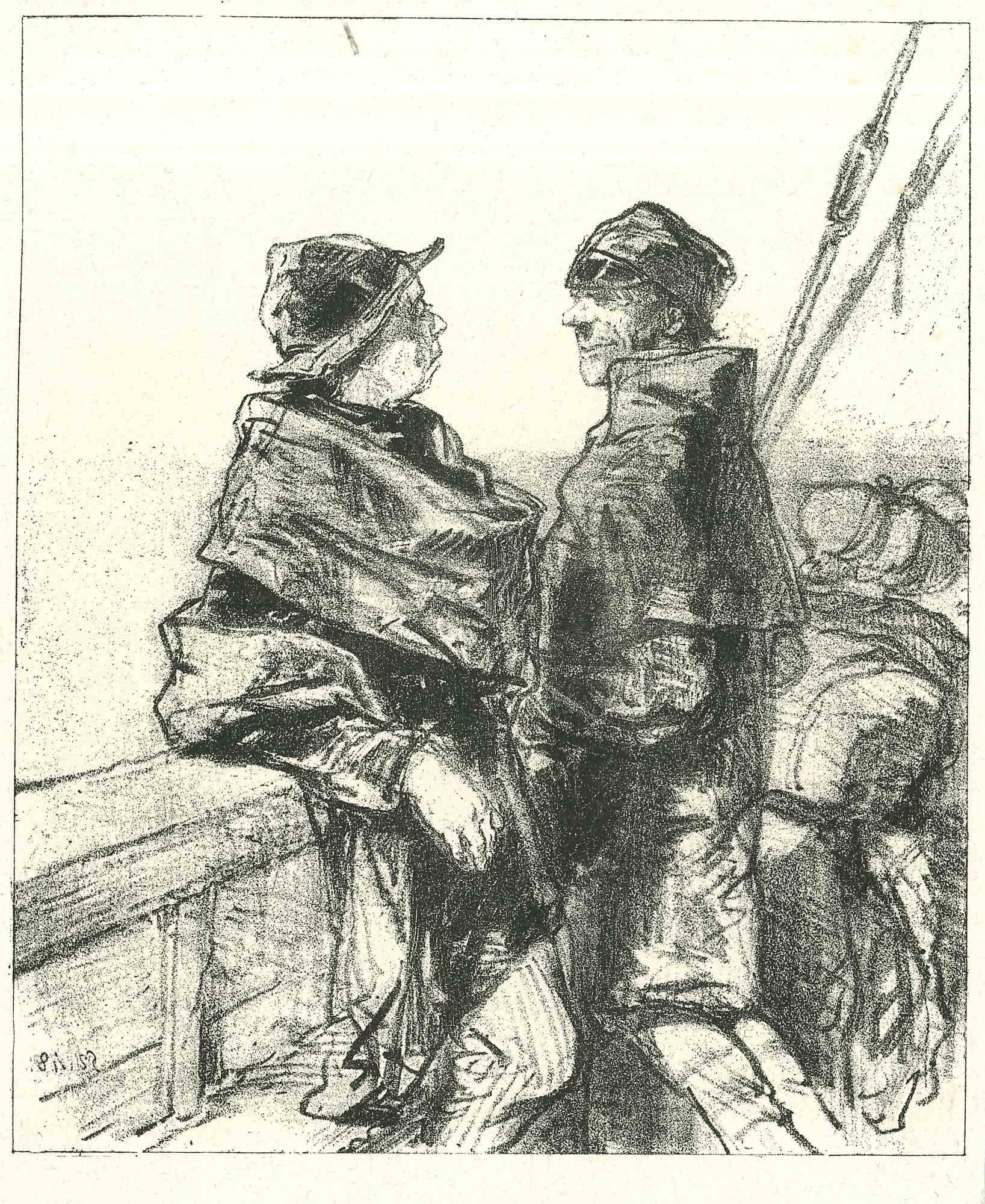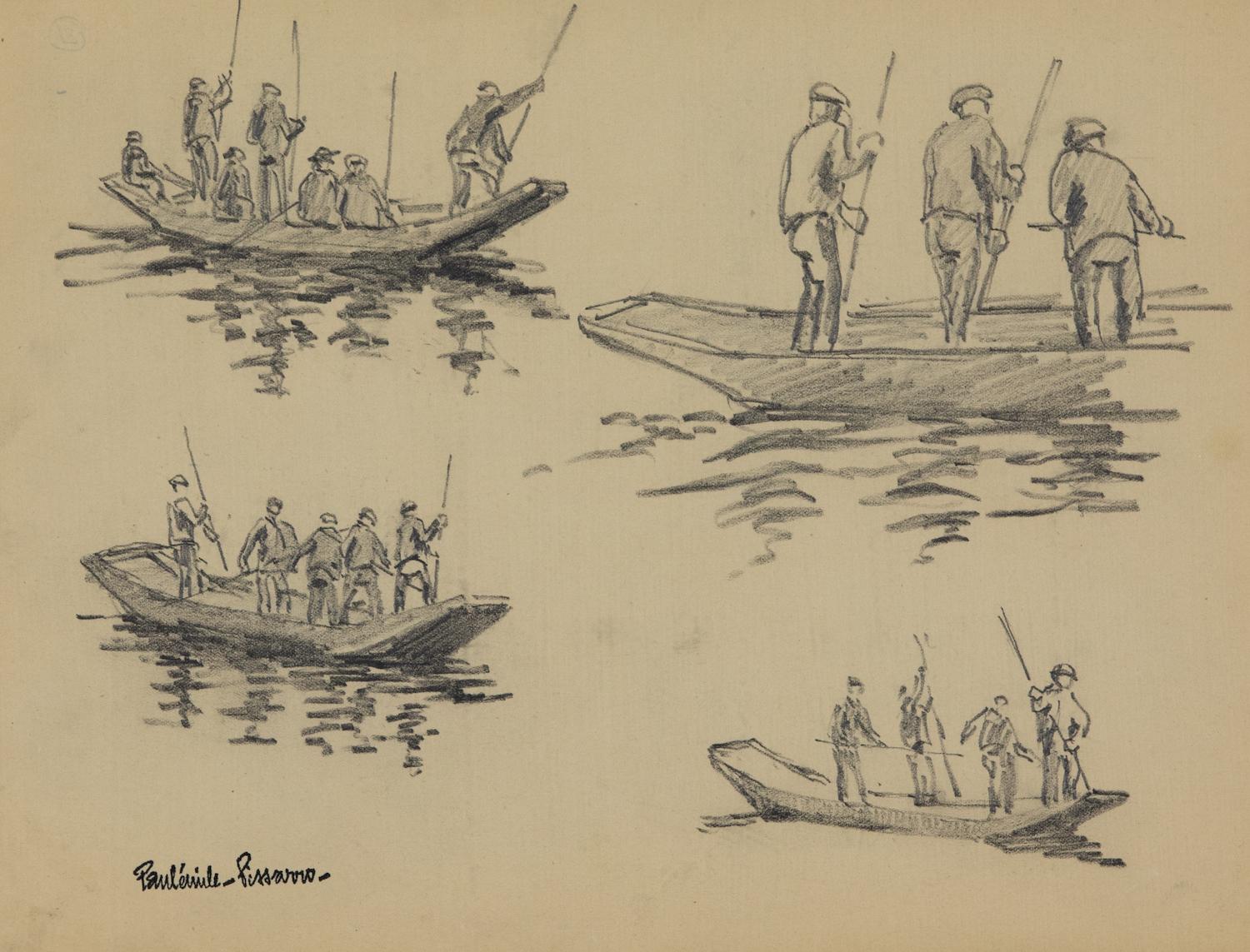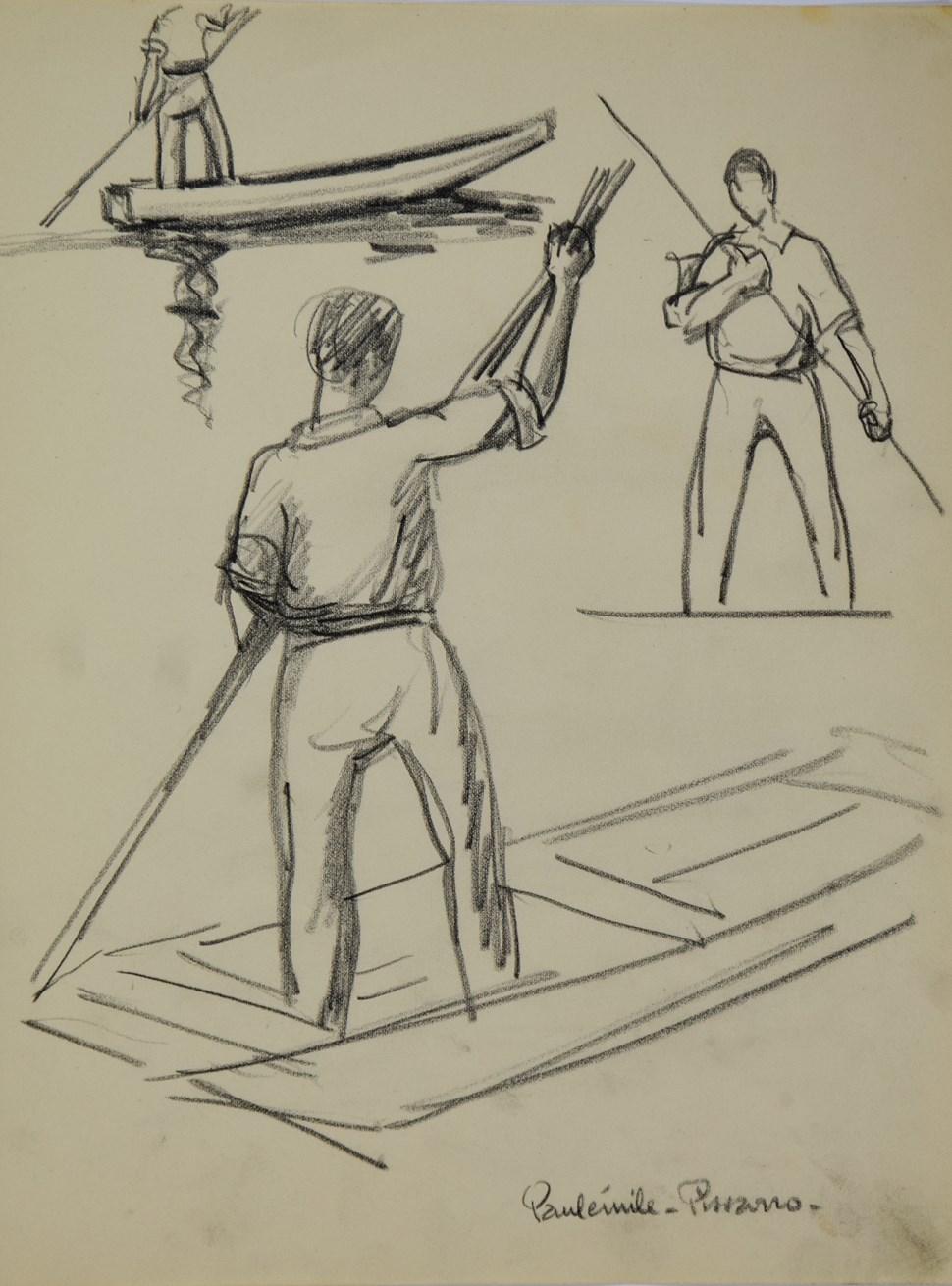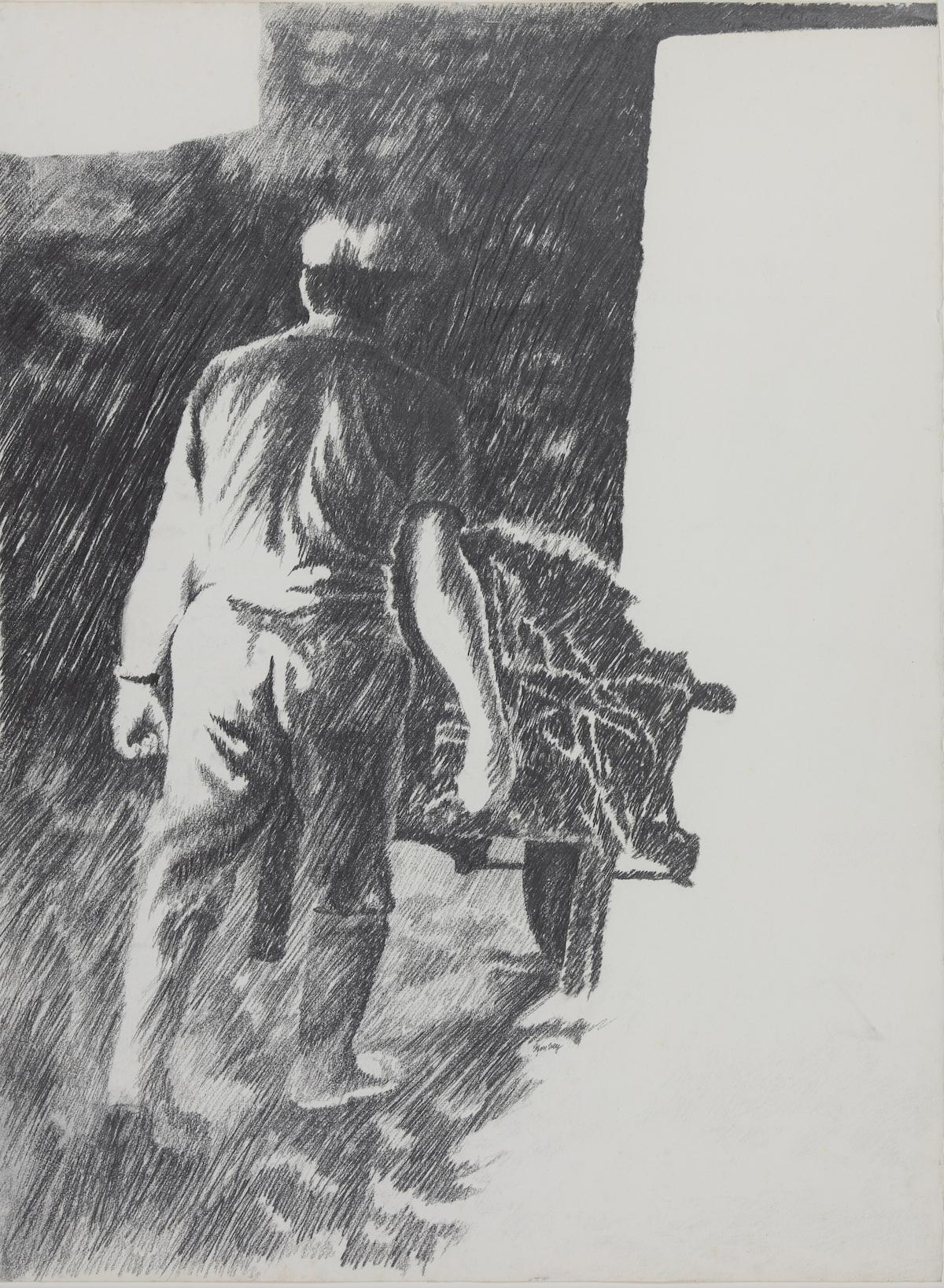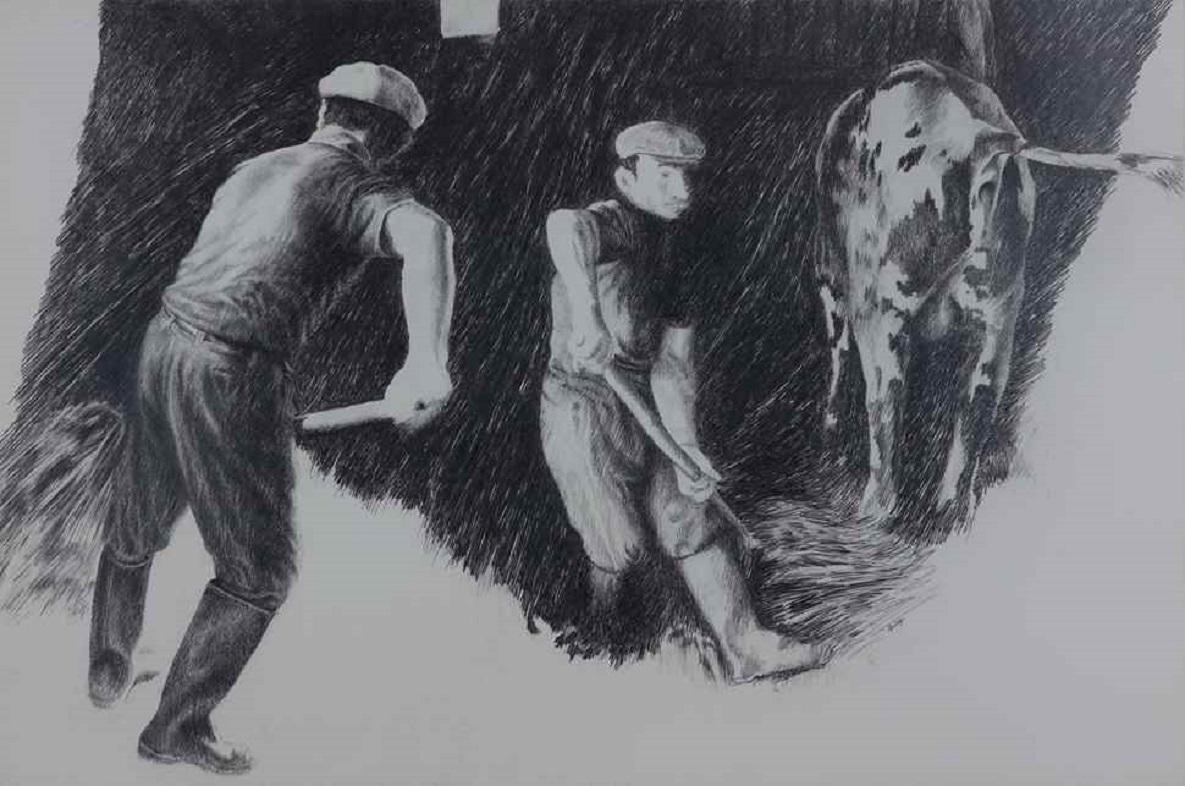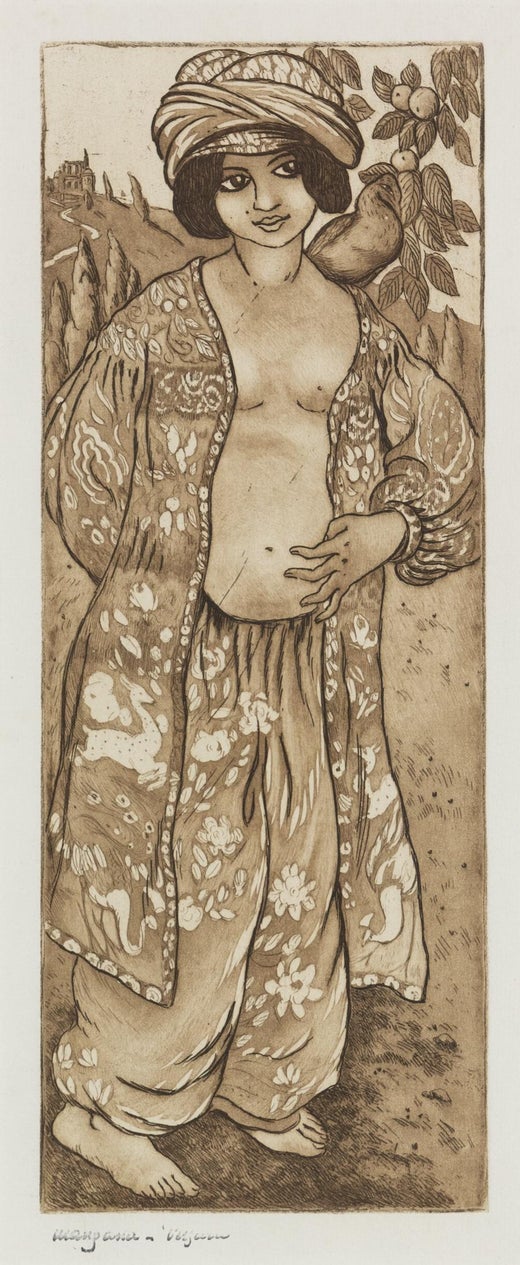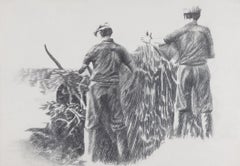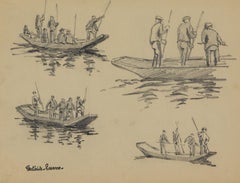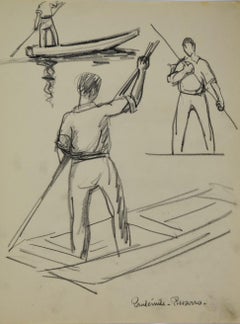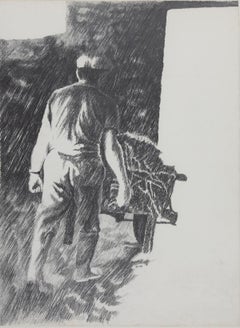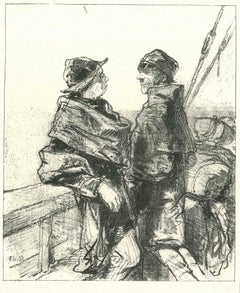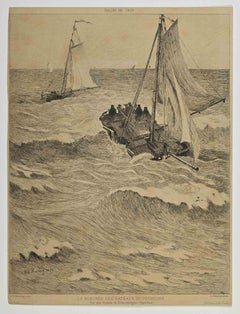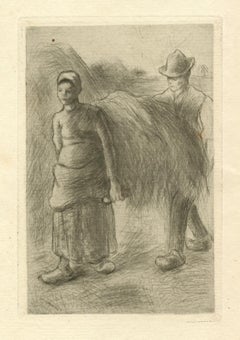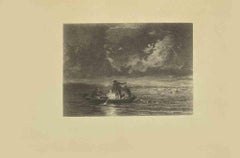Items Similar to Les pêcheurs de Concarneau by Georges Manzana Pissarro - Etching Print
Want more images or videos?
Request additional images or videos from the seller
1 of 4
Georges Manzana PissarroLes pêcheurs de Concarneau by Georges Manzana Pissarro - Etching Print1904
1904
$810.78
£590
€696.96
CA$1,124.94
A$1,260.38
CHF 655.45
MX$15,270.50
NOK 8,350.79
SEK 7,795.75
DKK 5,202.62
About the Item
SOLD UNFRAMED
Les pêcheurs de Concarneau by Georges Manzana Pissarro (1871 - 1961)
Etching
22.5 x 17.7 cm (8 ⁷/₈ x 7 inches)
Inscribed and dated lower left, and signed lower right, manzana - Pissarro
Executed in 1904
Like all second-generation Pissarro artists, Georges Henri ‘Manzana’ Pissarro initially worked under a pseudonym. Born in 1871, Manzana was the third of Camille Pissarro’s seven children, adopting the name ‘Manzana’ in 1894 after the maiden name of his maternal grandmother. It was not until around 1910, to honour his deceased father, that he employed his family name when signing his work.
Manzana studied with his father from an early age and spent his formative years surrounded by the distinguished artists associated with the Impressionist movement – Claude Monet, Paul Cézanne, and Paul Gauguin – who frequented the Pissarro home in Éragny. At his father's side he learnt not only to handle brush and pencil but also to observe nature and its changing qualities.
Subjected to rich and diverse influences, Manzana became a prolific and versatile artist, working with oil, pastel and watercolour as well as etchings, lithography and stencils. As a young man he adopted his father's purely Impressionist style and produced a series of landscapes around Éragny. He exhibited Impressionist works at the Salon d'Automne and the Salon des Indépendants, as well as Durand Ruel and Druet galleries in Paris in the early 1900s.
In 1906 his work began to evolve. Inspired by Dr Mardus’ French translation of ‘A Thousand and One Nights’, Manzana embarked on a grand project to publish his own illustrated version of these magical tales. This pulled Manzana into the umbrella of the decorative arts movement where he flourished creating tapestries, glassware, furniture, ceramics and metal work, all inspired by Orientalism and often incorporating gold, silver and copper paint. In 1907 he had his first exhibition of decorative works at Vollard but it was the 1914 exhibition at the Musée des Arts Décoratifs in Paris which dramatically boosted his career. Here he exhibited 311 works including tapestries, carpets, furniture, glassware, decorative paintings, etchings and lithographs.
The subsequent years were filled with bright ideas, gilded costumes and a glittering lifestyle as Manzana navigated the 20s and 30s between Les Andelys and Paris, spending many summers in Brittany. These culminated in a series of colourful yet delicate new works which Manzana exhibited prolifically. When war broke out in 1939 Manzana moved with his family to Casablanca, where he remained until 1947. Manzana was married and widowed three times. The last years of his life were spent in Menton with his son Félix who was also an accomplished artist. There Manzana returned to the Impressionist tradition of his early years, painting the serene landscapes that surrounded him.
Georges Manzana Pissarro
Like all second-generation Pissarro artists, Georges Henri ‘Manzana’ Pissarro initially worked under a pseudonym. Born in 1871, Manzana was the third of Camille Pissarro’s seven children, adopting the name ‘Manzana’ in 1894 after the maiden name of his maternal grandmother. It was not until around 1910, to honour his deceased father, that he employed his family name when signing his work. Manzana studied with his father from an early age and spent his formative years surrounded by the distinguished artists associated with the Impressionist movement – Claude Monet, Paul Cézanne, and Paul Gauguin – who frequented the Pissarro home in Éragny. At his father's side he learnt not only to handle brush and pencil but also to observe nature and its changing qualities. Subjected to rich and diverse influences, Manzana became a prolific and versatile artist, working with oil, pastel and watercolour as well as etchings, lithography and stencils. As a young man he adopted his father's purely Impressionist style and produced a series of landscapes around Éragny. He exhibited Impressionist works at the Salon d'Automne and the Salon des Indépendants, as well as Durand Ruel and Druet galleries in Paris in the early 1900s. In 1906 his work began to evolve. Inspired by Dr Mardus’ French translation of ‘A Thousand and One Nights’, Manzana embarked on a grand project to publish his own illustrated version of these magical tales. This pulled Manzana into the umbrella of the decorative arts movement where he flourished creating tapestries, glassware, furniture, ceramics and metal work, all inspired by Orientalism and often incorporating gold, silver and copper paint. In 1907 he had his first exhibition of decorative works at Vollard but it was the 1914 exhibition at the Musée des Arts Décoratifs in Paris which dramatically boosted his career. Here he exhibited 311 works including tapestries, carpets, furniture, glassware, decorative paintings, etchings and lithographs. The subsequent years were filled with bright ideas, gilded costumes and a glittering lifestyle as Manzana navigated the 20s and 30s between Les Andelys and Paris, spending many summers in Brittany. These culminated in a series of colourful yet delicate new works which Manzana exhibited prolifically. When war broke out in 1939 Manzana moved with his family to Casablanca, where he remained until 1947. Manzana was married and widowed three times. The last years of his life were spent in Menton with his son Félix who was also an accomplished artist. There Manzana returned to the Impressionist tradition of his early years, painting the serene landscapes that surrounded him.
About the Seller
5.0
Recognized Seller
These prestigious sellers are industry leaders and represent the highest echelon for item quality and design.
Established in 1964
1stDibs seller since 2015
103 sales on 1stDibs
Typical response time: 4 hours
Associations
Society Of London Art Dealers
- ShippingRetrieving quote...Shipping from: London, United Kingdom
- Return Policy
Authenticity Guarantee
In the unlikely event there’s an issue with an item’s authenticity, contact us within 1 year for a full refund. DetailsMoney-Back Guarantee
If your item is not as described, is damaged in transit, or does not arrive, contact us within 7 days for a full refund. Details24-Hour Cancellation
You have a 24-hour grace period in which to reconsider your purchase, with no questions asked.Vetted Professional Sellers
Our world-class sellers must adhere to strict standards for service and quality, maintaining the integrity of our listings.Price-Match Guarantee
If you find that a seller listed the same item for a lower price elsewhere, we’ll match it.Trusted Global Delivery
Our best-in-class carrier network provides specialized shipping options worldwide, including custom delivery.More From This Seller
View AllFarmhands by Yvon Pissarro - Figurative drawing
By Yvon Pissarro
Located in London, GB
Farmhands by Yvon Pissarro (b. 1937)
Pencil on paper
75 x 108 cm (29 ¹/₂ x 42 ¹/₂ inches)
Signed lower right, Yvon Vey
Provenance: Studio of the Artist, Montpellier
Artist biograph...
Category
1980s Modern Figurative Drawings and Watercolors
Materials
Paper, Pencil
Pêcheurs by Paulémile Pissarro - Drawing of fishermen
By Paul Emile Pissarro
Located in London, GB
Pêcheurs by Paulémile Pissarro (1884-1972)
Pencil on paper
23.1cm x 30.9
Stamped lower left, Paulémile-Pissarro-
This work is accompanied by a certificate of authenticity by Lélia P...
Category
Mid-20th Century Post-Impressionist Figurative Drawings and Watercolors
Materials
Paper, Pencil
Hommes Pagayant, Work on paper by Paulémile Pissarro - Drawing
Located in London, GB
SOLD UNFRAMED
Hommes Pagayant, Painting by Paulémile Pissarro
Graphite and charcoal on paper
27 x 20.3 cm (10 ⁵/₈ x 8 inches)
Signed lower right, Paulémile-Pissarro-
Provenance
Est...
Category
1930s Post-Impressionist Drawings and Watercolor Paintings
Materials
Paper, Charcoal, Graphite
Farmhands by Yvon Pissarro - Figurative work on paper
By Yvon Pissarro
Located in London, GB
Farmhands by Yvon Pissarro (b. 1937)
Conté chalk on paper
76 x 56.5 cm (30 x 22 ½ inches)
Signed lower middle Yvon Vey
Executed in 1983
Provenance
Studio of the artist, Montpellier
...
Category
1980s Contemporary Figurative Drawings and Watercolors
Materials
Paper, Chalk
Farmhands, Pencil on Paper Drawing by Yvon Pissarro, Signed
By Yvon Pissarro
Located in London, GB
Farmhands by Yvon Pissarro (b. 1937)
Pencil on paper
79 x 108 (31 ¹/₈ x 42 ¹/₂ inches)
Signed upper right, Yvon Vey
Provenance
Studio of the Artist, Montpellier
Artist's Biography
...
Category
21st Century and Contemporary Figurative Drawings and Watercolors
Materials
Paper, Pencil
Lavandières by Lélia Pissarro - Figurative etching
By Lelia Pissarro
Located in London, GB
Lavandières by Lélia Pissarro (b. 1963)
Etching
12 x 15.5 cm (4 ³/₄ x 6 ¹/₈ inches)
Signed lower left, Lélia Pissarro.
Numbered lower right, 14/15
Artist biography:
Born in Paris i...
Category
1990s Figurative Prints
Materials
Etching
You May Also Like
Fishermen - Original Lithograph after Paul Gavarni - 1881
By Paul Gavarni
Located in Roma, IT
Fishermen is an original lithograph artwork on ivory-colored paper, realized by the French draftsman Paul Gavarni (after) (alias Guillaume Sulpice Chevalier Gavarni, 1804-1866) in Pa...
Category
1880s Modern Figurative Prints
Materials
Paper, Lithograph
La Rentrée des Bateaux des Pêcheurs - Etching by Lèon Gaucherel - 19th Century
By Léon Gaucherel
Located in Roma, IT
La Rentrée des Bateaux des Pêcheurs is an artwork realized by Léon Gaucherel in the 19th Century .
Etching.
Signed on Plate.
Category
1860s Modern Figurative Prints
Materials
Etching
"Paysans portant du foin" original etching
By Camille Pissarro
Located in Henderson, NV
Medium: original etching and drypoint. Catalogue reference Delteil 126. Printed on laid paper in 1900 and published in Paris by Henri Floury as the frontispiece for Gustave Geffroy's...
Category
Early 1900s Impressionist Prints and Multiples
Materials
Etching
Fishermen - Etching by Eugène Burnand - Late 19th century
Located in Roma, IT
Fishermen is an original etching realized by Eugène Burnand (1850-1921) in the Late 19th century.
Good conditions with foxing.
The artwork is realize...
Category
Late 19th Century Modern Figurative Prints
Materials
Engraving, Etching
Fishermen - Etching by Eugène Burnand - Late 19th century
Located in Roma, IT
Fishermen is an original etching realized by Eugène Burnand (1850-1921) in the Late 19th century.
Good conditions with foxing.
The artwork is realize...
Category
Late 19th Century Modern Figurative Prints
Materials
Engraving, Etching
The Men - Original Lithograph by Paul Gavarni - 1881
By Paul Gavarni
Located in Roma, IT
Two men is an original lithograph artwork on ivory-colored paper, realized by the French draftsman Paul Gavarni (after) (alias Guillaume Sulpice Chevalier Gavarni, 1804-1866) in Pari...
Category
1880s Modern Figurative Prints
Materials
Lithograph
More Ways To Browse
Maiden Home
Antique Umbrella Handles
Antique Umbrella Gold
Antique Metal Stencils
Bearbrick Andy Warhol
Don Quixote Etching
Hockney Sun
Hope Chest Used
Isadora Duncan
Jose Oliver
Kaws Lithograph
Les Grands Boulevards
Moses Etching
Native American Shield
Philip Weber
Piano Poster
Picasso Lithographs Jacqueline
Russian Piano
